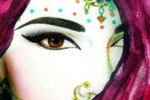Last week, I reviewed Emma Tarlo’s book Visibly Muslim: Fashion, Politics, Faith. This week, I got the chance to speak with her further about the book and her experiences writing it.
Sara: Was there any inter-generational tension involving “newer” hijab fashions?
Emma Tarlo: With most of the people I interviewed, their mothers did not wear hijab so the parents did not object. In a few cases mothers even adopted hijab following their daughters’ examples. More often, I came across cases where parents were slightly disconcerted that their daughters wanted to wear it, thinking that it would make life more difficult. As far as wearing hijab in fashionable styles was concerned, I never found parents objecting to that, although some religious leaders do raise complaints about contemporary hijab fashions making women look more beautiful and thereby detracting from what they see as the central meaning of hijab. Such tensions over how hijab should look are not just inter-generational. Some young women who favour more pious styles also object to new hijabi fashions.
In some South Asian families, inter gernational tensions are more often over styles of dress, with mothers favouring more Asian styles and objecting to their daughters wearing what they consider “Western” fashions such as jeans, skirts, etc. Whilst daughters might accuse their mothers of being too influenced by Asian cultural styles, mothers often complain that their daughters’ clothes are “too Western.” By wearing fashion “Western” clothing with hijab, young Muslim women can assert some independence in relation to their parents whose life style they often perceive as too tradition-bound.
S: At MMW, we struggle with not wanting to see hijab as central to Muslim women’s issues, is this something you came across in women?
ET: I was extremely aware of this issue, and didn’t want to perpetuate the idea that the key to understanding Muslim women is “the veil”. I was also very aware that many young Muslim women feel that outsiders are obsessed with the veil. But what interested me was not so much the outsider obsession with covering as the complex internal debates taking place about dress amongst Muslims in Britain and Europe and the USA. With the polarisation of the veiling issue in the media, particularly in the post 9/11 environment, there has been very little space for acknowledgement of the diversity of Muslim perspectives on dress. Instead Muslims are all too frequently blanketed together as if they all think and act alike with the most extreme forms of covering becoming the major point of focus even though face veiling is very much a minority practice which many Muslims oppose. I wanted to bring out this diversity and to show that contemporary Muslim dress practices are not just about religion and politics but also about ethics, aesthetics, identity, fashion, globalisation, community, belonging and so forth. In a way this was also part of larger project for showing how Muslim women, like all women, are juggling with the complexities of what to wear in a context where others project interpretations on them. What is particular in the case of hijabi women is the degree of expectations and potential interpretations and misinterpretations with which they have to engage as they go about their ordinary lives. So I wanted to bring out lived experiences of visibly Muslim women without suggesting the hijab is the most important aspect of their lives or even their appearances.
S: What I appreciated was the humanizing quality of your book. Could you reflect on that?
ET: One of the problems with the persistence of ill informed stereotypes of Muslims is that all too often they are portrayed and perceived as “other” by people who fail to recognise the many aspects and concerns in life that they may share in common. So bringing out the human side of people’s clothing experiences was important. After all everyone has to get dressed and most people are concerned with their appearances to some degree. In this sense, dress is an interesting issue for everyone. When I began the research I thought women might not like me asking too many questions about this issue, but to my surprise I found people extremely receptive to the research. I think this is partly because as young Muslim women they have had to think very carefully about their appearances, often juggling conflicting expectations of parents, friends, media, religious leaders, other Muslims with different views etc. As a result the women I met were extremely thoughtful and articulate about their clothing dilemmas and solutions and were often keen to share their reflections with anyone willing to recognise the complexity.
S: In looking at the way that Muslim women are changing, it is interesting to consider how that impacts Muslim men, especially in the search for a partner. From the women you spoke to, how did that impact in that sense?
ET: I met a lot of very feisty, intelligent and interesting young hijabi women but I got the impression that they were having difficulty finding equivalent men. My research amongst men was much more limited but I got the impression that many of the men who took their religion seriously were often more conservative in their attitudes which meant they would not suit these young hijabi women. Their dilemma seemed to be how to find partners who are religious active, but also socially and politically progressive.
S: One thing that I was wondering about when reading the book was the role of socioeconomic class, could you talk more about that role?
ET: This links back to the starting point of the book. Coming from an anthropological background, I was aware that there was a tendency for researchers to focus on poor, working class Muslim neighbourhoods and to see things through the lens of “tradition”. But I was keen to capture the dynamic nature of Muslim appearances and felt that I wanted to do multi-cited research and to look also to the cosmopolitan university-educated Muslim milieu, including the internet. But of course class, education and location all play an important part in delineating the possibilities of how a person might dress. I do touch on these issues to some extent in the book, particularly when I talk in terms of the pressure to dress in particular ways in certain localities, but there is much more research to be done on this issue.
S: Often times, the hijab is portrayed as a stand against the Western idea of beauty. Did you find that there was a struggle between hijab becoming a part of a more superficial industry and the religious meaning?
ET: There are tensions here of course. Like everyone else, Muslim women are caught up in consumer culture. They want to critique it on the one hand and find themselves participating in it on the other. I think many women can identify with that dilemma. Certainly many Muslim women talk about hijab in terms of a rejection of “Western consumerism” and beauty ideals. At the same time most still want to look attractive and do not want to be seen simply as a walking symbol of piety.
The people involved in designing and marketing new Islamic fashions are also very preoccupied with these issues. They want to try to define a new balance between what is modest and what is beautiful. Inevitably they are participating in consumer culture through selling fashion products. What they try to do however is make these products look attractive without their necessarily having to be sexually provocative. I think there are many non-Muslim women who share a desire for clothes that are attractive without being overtly revealing or sexually provocative.



